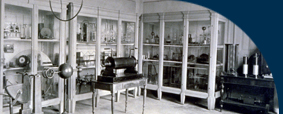|
OUR COLLECTION OF SCIENTIFIC INSTRUMENTS
HEAT |

 |
Six and Bellani's thrrmometrograph |
 |
Termometrografo di Six e Bellani |
| Subjects: heat/maximum and minimum temperature reader |
Settore: calore/ misuratore della temperatura massima e minima |
| Inventory Number: 94 |
Numero di inventario: 94 |
| On the lower part of the stand: "1851 Amadori fece in Bologna" [hand painted] |
Sulla base inferiore del supporto: "1851 Amadori fece in Bologna" [pitturato a mano] [documento] |
| Expense: two "scudi" |
Costo: due scudi [documento] |
| Walnut, glass, mercury, alcohol |
Materiale utilizzato: Noce, vetro, mercurio, alcool |
| 67 X 385 X 15 [mm] |
Dimensioni: 67 X 385 X 15 [mm] |
| |
|
Inscriptions: on the upper part of the board: "Six's thermometrograph. Reamur's scale". |
Iscrizioni: sulla parte superiore della tavoletta, "Termometrografo di Six. Scala di Réaumur". |
| |
|
This is practically a maximum and minimum thermometer, which was designed by the English scientist James Six (1731-1793) at the end of the 18th century and was later improved by Angelo Bellani (1776-1852), who first used the term "thermometrograph". He was a priest from Monza and one of the very first to establish industrial production of precision thermometers and of meteorological instruments. The major advantage of this thermometer was that it supplied the various measurements without the constant presence of an observer. This instrument is dated and signed by the "engineer" Cesare Amadori [1] from Bologna. An account of expenditures, written by Father Alessandro Serpieri, reveals that the instrument was purchased towards the end of the year 1851 at the cost of two scudi (italian coin used in Bologna at that time). |
É in sostanza un termometro a massima e minima ideato dallo scienziato inglese James Six (1731-1793) verso la fine del XVIII secolo ed il cui perfezionamento è legato al nome di Angelo Bellani (1776-1852, che coniò anche il termine termometrografo), canonico monzese, tra i primi in Italia ad avviare una produzione "industriale" di termometri di precisione e di strumenti per la meteorologia. Il pregio principale di questo termometro era quello di fornire le misure senza la presenza costante di un osservatore. Questo strumento è datato e firmato dal "macchinista" bolognese Cesare Amadori [1]. Da una nota di spese redatta dal Padre Alessandro Serpieri, apprendiamo che lo strumento fu acquistato verso la fine del 1851 al costo di scudi due. |
| |
|
Description: A long, thin U-shaped tube is linked to a small square wall-board with an iron wire, a small alcohol container on its left end and an ampoule on its right end with both of them perfectly sealed. On the right and on the left the ampoules and the thin tubes linked to them contain alcohol (which is presently missing on the right), in the middle the thin tube contains mercury. Painted on both sides of the board there is a temperature scale that was used, which is Réamur's scale [2]. The minumum temperature (on the left) ranges from -20 to +30; near the numbers 0 and +20 we find the writings gelo (ice), and caldo (hot), respectively. The maximum temperatures (on the right) range from -10 to +40 with the following labels: 0=gelo (ice), 5=brina (hoar-frost), 10=temperato (mild), 20=bigatti (silkworms) and 25=bagni (baths). As is known, silkworms are actually silkworm caterpillars and this is the ideal temperature for their breeding. Two small metal pointers are enclosed in glass bulbs which are reduced to thin glass strands on the upper part. The bulbs move freely within the right and left tubes and separate the mercury from the alcohol. They are built in such a way that mercury (because of surface tension) can push them only upwards. |
Descrizione: Su una tavoletta rettangolare in noce da parete è fissato mediante un filo di ferro un lungo tubicino ad U, con un serbatoio d'alcool alla sua estremità sinistra ed una ampollina all'estremità destra, entrambe perfettamente chiuse. A sinistra e a destra, le ampolle e una parte dei tubicini annessi sono riempiti d'alcool (attualmente mancante a destra), nella parte centrale il tubicino è riempito di mercurio. Ai lati della tavoletta è pitturata la scala di temperatura usata, che è quella Réamur [2]. La temperatura minima (a sinistra) ha valori compresi tra -20 a +30; accanto ai valori 0 e +20 c'è scritto, rispettivamente, gelo e caldo. La temperatura massima (a destra) va da -10 a +40, con le seguenti iscrizioni: gelo per 0 gradi; brina per 5 gradi; temperato per 10 gradi; bigatti per 20 gradi e bagni per 25 gradi. Come è noto i bigatti sono i bachi da seta e la temperatura indicata è quella ottimale per il loro allevamento. Due piccoli chiodini metallici, rinchiusi in sottili ampolle di vetro che si riducono ad un filino di vetro nella parte superiore, possono scorrere liberamente nei tubicini e fungono da indici metallici. Essi sono alloggiati all'interno dei tubicini di destra e di sinistra e separano il mercurio dall'alcool. Gli indici sono costruiti in modo tale che il mercurio (a causa della tensione superficiale) li possa spingere solo verso l'alto. |
| |
|
Function: as temperature rises the mercury and the alcohol expand, the left pointer is kept still whereas the right one is pushed up. Conversely, as the temperature falls, the opposite effect takes place. The mercury and the alcohol shrink and the right pointer remains in the same position it held after the expansion, whereas the left pointer is elevated. In this manner it is possible to measure the highest and lowest temperatures obtained during the measurement. In order to carry out a further measurement the metal pointers are placed strictly close to the mercury with the use of a magnet. |
Funzionamento: al crescere della temperatura il mercurio e l'alcool si dilatano, mantenendo stazionario l'indice di sinistra e spingendo verso l'alto l'indice di destra. Al diminuire della temperatura si verifica l'effetto inverso: il mercurio e l'alcool si ritirano, mantenendo stazionaria la posizione che l'indice di destra aveva raggiunto nella precedente dilatazione ed innalzando l'altro indice di sinistra. Con tali indicatori si è in grado di rilevare la temperatura massima e minima raggiunte durante il periodo di misura. Per effettuare una nuova misura si riportano gli indici metallici a contatto col mercurio, agendo dall'esterno mediante una calamita. |
| |
|
Bibliography: Bellani [1811], pp. 89-110; Barlocci [1845], Vol. I, 1st and 2nd parts, Table III, pp. 156-157; Jamin [1886], p. 137; Bernardini, Mantovani, Vetrano [1987], pp. 121-122; Société des Lunetiers [1908], p. 49. [1] Little is known of this mechanician in charge of maintenance who was also instrument maker. He worked as a mechanician within the Gabinetto di Fisica at the Pontifical University of Bologna, in collaboration with Giovanni Aldini. Upon Aldini's death (1834) Amadori undertook the task of cataloguing Aldini's collection. In 1851 he was appointed assistant within the Aldini technical school of mechanical physics. [2] The Réamur temperature is 8/10 of the centigrade temperature. |
Bibliografia: Bellani [1804], Tomo I, pp. ; Bellani [1811], pp. 89-110; Despretz [1835], tomo I, p. 78, tav. III, fig. 12; Barlocci [1845], Tomo I, Parte I e II, Tav. III, pp. 156-157; Jamin [1886], p. 137; Bernardini, Mantovani, Vetrano [1987], pp. 121-122; Sociètè des Lunetiers [1908], p. 49; Archivio Comunale, Busta 113, Fascicolo 1 [1] Scarse notizie abbiamo di questo artigiano meccanico, addetto alla manutenzione ma anche costruttore di strumenti scientifici. Lavorò come meccanico presso il Gabinetto di Fisica della Pontificia Università di Bologna collaborando con Giovanni Aldini. Alla morte di quest'ultimo (1834) fu incaricato di redigere l'inventario della collezione Aldini. Nel 1851 viene nominato assistente alla scuola tecnica Aldini di fisica meccanica.
[2] Si ricorda che la temperatura Réamur è 8/10 di quella centigrada. |
|
|
|

